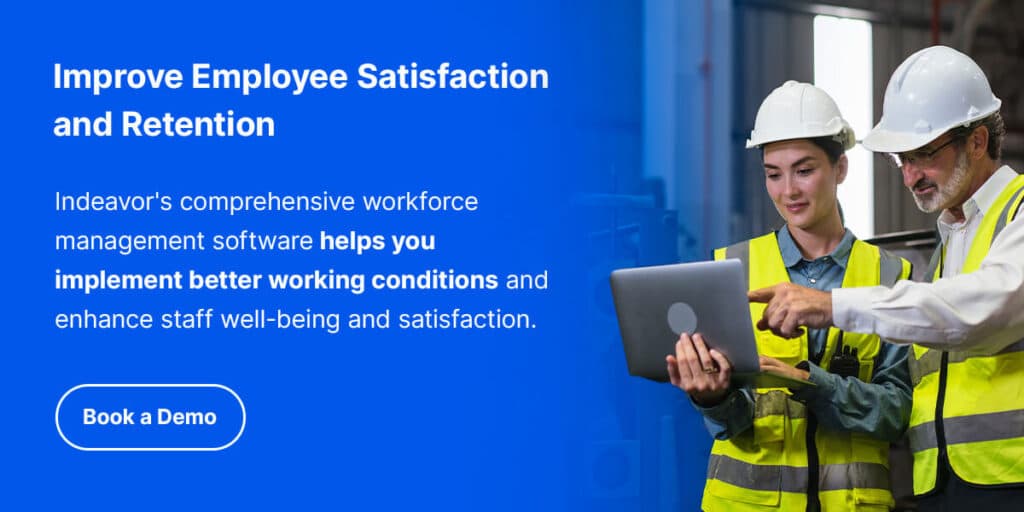Your staff is the core of your company — they contribute to your productivity, sales, and image. If you want your workforce to stay committed to your business, you must prioritize their well-being at work. Employee burnout may be more common in your organization than you think, leading to dissatisfied and disengaged teams.
Improving employee satisfaction and wellness are two ways to help with preventing employee burnout and enhance retention. Additionally, workplace management software helps businesses improve their employees’ work conditions, foster engagement, and lower staff turnover. With the right strategies in place, your company can build a happier, more satisfied workforce.
What Is Employee Burnout?
Employee burnout is work-related stress causing hopelessness, physical and mental exhaustion, and self-depreciation. It differs from daily work stressors such as deadlines and meetings and can severely impact employees’ well-being and work performance.
It can be challenging to notice burnout as it can affect staff differently. However, there are some common signs and symptoms of employee burnout to be aware of:
- Emotional depletion
- Increased illness and absenteeism
- Reduced energy levels
- Social detachment and exclusion
- Low-work quality
- Frequent irritability and defensiveness
- Reduced concentration
- Cynicism toward co-workers and work in general
- Emotional outbursts
- Pessimistic attitude toward the company
- Physical exhaustion
- Lack of participation in work and company engagements
The Impact of Burnout on Productivity and Company Culture

Burnout across your teams can lead to serious issues, such as:
- Reduced productivity: Employees might do less work or take longer to complete tasks, leading to work backlogs and missed deadlines.
- Decreased engagement: Staff loses interest, pride, enjoyment, and fulfillment in their work, leading them to do the bare minimum, which impacts work quality.
- High staff turnover: Retaining skilled and experienced staff can become challenging as more employees resign.
- Increased health care expenses: Companies may have high medical expenditures due to more employee illnesses and absenteeism.
Preventing employee burnout requires proactive strategies, such as promoting work-life balance, offering flexible scheduling, and encouraging open communication. By recognizing the early signs of burnout and addressing its root causes, organizations can maintain a healthier, more engaged workforce and avoid the costly impacts of burnout.
Strategies for Preventing Employee Burnout
Preventing employee burnout can lead to an increase in staff well-being, motivation, and satisfaction, reducing burnout and the adverse effects that come with it. Understanding employee burnout how it starts, its warning signs, and implementing proactive strategies to address it can help organizations create a healthier, more supportive work environment. From improving scheduling practices to fostering open communication and promoting work-life balance, there are several ways to minimize burnout and enhance long-term employee retention and performance.
1. Invest in Innovative Scheduling
Innovative scheduling includes technology and software to automate staff schedules, manage absenteeism, promote workplace flexibility, and approve time off requests. Enhancing your scheduling process can give employees more control over their daily timetables, limit overworking or extended hours, and improve work-to-home life balance.
Overall, optimizing your organization’s scheduling processes can play a crucial role in preventing employee burnout by allowing staff more work flexibility, ensuring fair shift distribution, and reducing the risk of chronic overwork. This not only supports employee well-being but also boosts productivity and long-term retention.
2. Create Flexible Work Arrangements
Allowing employees to work remotely or in a hybrid arrangement can provide them with more balance between their work and personal lives. Employees with more time to focus on their families and other personal responsibilities can feel less confined to work. This balance and freedom can improve your staff’s outlook on work, making them more motivated, satisfied, and aid in preventing employee burnout.
With mobile scheduling solutions, companies can give employees the autonomy to plan their days and weeks. These mobile tools allow staff to conveniently communicate their personal needs, like doctors’ appointments or school commitments, and schedule work or shifts around them.
You can view staff paid time off, sick leave, and overtime and delegate work according to your team’s availability. This way, you allow your staff to have a healthy balance between work and life and prevent them from feeling overwhelmed or overexerted.
3. Gain Insight From Workforce Analytics
Overscheduling staff can lead to burnout. Additionally, scheduling too many employees for the day can lead to a lack of productivity and greater job dissatisfaction. Without visibility or insight into employee shift timetables and history, these scheduling errors can happen often.
Automated scheduling software provides workforce analytics, allowing you to view and track employee data and history. This data enables you to prevent overscheduling staff for the week, day, and month and helps you provide your team with adequate downtime to rest and focus on personal priorities.
Software also helps you coordinate schedules according to the complexity of projects. If you have an intricate or minor project to complete, you can schedule staff with suitable skills instead of having all your employees on site. By using data-driven scheduling strategies, organizations can improve productivity while preventing employee burnout and supporting long-term staff well-being.
8 Ways to Improve Employee Well-Being and Retention
Employee well-being refers to an employee’s mental, physical, and emotional health. When you support the well-being of your staff, you can create a positive and healthy work environment that promotes productivity, creativity, and fulfillment and reduces stress. Employees who try to do their best at work are often more likely to go above and beyond in their duties, provide valuable input, have a positive outlook, and stay at a company longer.
Employee wellness and retention go hand in hand. Wellness programs are an excellent strategy to promote staff longevity. They support employee needs and give them a sense of purpose, inspiring them to stay committed to the organization. Prioritizing ways to improve employee well-being can help you address and mitigate negative work cultures, therefore burnout how to prevent becomes a key focus. By creating a supportive, balanced work environment, you help employees thrive, which reduces burnout risk and strengthens long-term organizational success.
The Benefits of Employee Wellness Programs
Wellness programs are a great way to invest in your employees and can serve as the foundation of your employee retention strategies. Employees who feel cared for can feel more positive about work, reducing absenteeism, improving performance, boosting engagement, and preventing employee burnout. Here are some benefits of workplace wellness programs:
- Show employees you care: When you back up your company values with actionable support and care, employees can feel more appreciated and committed to their work and the company.
- Promote health and wellness: Physical and mental health wellness initiatives can address employee medical conditions that affect their work. You can reduce absenteeism and medical expenditure when staff has suitable health support.
- Increase employee satisfaction: Wellness programs can address employee dissatisfaction, like negative company views, poor work ethic, and low productivity. Implementing wellness initiatives like social activities, team building, and reframing employees’ work perspectives can encourage more engagement.
- Promote employee loyalty: Employees can be proud to be a part of a company that invests in them, making them more likely to stay at the business for longer.
- Reduce stress: Work stress can strain and overwhelm employees, leading to burnout. Wellness programs focus on mental and physical well-being and increased work-life balance, which can relieve stress and anxiety, helping employees stay energized and positive.
- Encourage teamwork: Initiatives like team-building and socializing foster a culture of collaboration, improve cooperation, support, and understanding between colleagues, and reduce conflicts.
Employee wellness programs can include various components and focuses to help your organization reap many benefits.
1. Promote Employee Recognition and Rewards

Recognizing and rewarding employees for factors like work quality and project turnover is a great way to foster a motivated workforce. When staff feel appreciated, they might be more willing to turn out high-quality work consistently. Rewards and recognition can include salary incentives, additional paid time off, and more work-from-home opportunities.
You can implement a reward system and personalize incentives using software solutions like workforce analytics. This software can help you track metrics like employee overtime, job turnovers, and how often workers fill in for colleagues, providing a convenient way to personalize rewards like bonuses and paid time off.
2. Train Leaders on Employee Engagement Approaches
Leadership behavior like listening to staff, providing feedback, identifying and providing growth opportunities, and creating a positive work environment can foster a culture of engagement. Managers who take time to understand their staff’s circumstances, listen to employee suggestions, and provide training and upskilling opportunities can make staff feel cared for and appreciated.
Upskilling and training leaders on empathy and communication is an excellent way to promote positive behaviors and work environments, fostering a culture of engagement while preventing employee burnout. When leaders recognize signs of stress and proactively address workload concerns, they can create a supportive environment that prioritizes both productivity and employee well-being.
3. Support Employee Mental Health
Acknowledging mental health in the workplace is essential, especially with conditions like anxiety affecting more and more workers. Creating an environment where employees can discuss factors affecting their mental health, like negative leadership, unrealistic deadlines, and overwhelming workloads, can help you prioritize strategies to address these concerns. Employees might also feel more confident about seeking mental health support when you make it a key component of your work culture.
Wellness initiatives can help staff manage stressors that can impact staff mental health. These strategies can address and alleviate work-related tensions and anxieties, limiting overexertion and preventing employee burnout. When employees have effective ways of dealing with stress, they can feel more supported and less likely to resign. Here are some well-known initiatives for supporting employee mental health and satisfaction:
- Onsite therapists and support groups
- Meditation rooms
- Yoga classes
- Mindfulness training
- Paid time off for mental health days
- Mandatory vacation time
- Relaxation and stress management activities
- Employee assistance programs
- Nap pods
- Green spaces
4. Reframe Performance Reviews
When managers or team leaders don’t have frequent checkpoints with staff on their challenges and achievements, employees have little insight into where they excel and areas they can improve. By regularly providing the team with feedback on their performances, they can make improvements throughout the year and feel more motivated by their achievements, making annual reviews less daunting. This ongoing feedback also helps in preventing employee burnout by addressing issues early and ensuring workloads remain manageable.
You can also reframe performance reviews by providing positive solutions to work through challenges and growth points. Instead of a negative review rating, you can set short-term goals for improvement, making staff feel more motivated to excel and positive about reviews. This proactive approach supports continuous growth while maintaining employee well-being.
5. Offer Physical Health Incentives
Employee illnesses and medical conditions can lead to additional time off and productivity loss. Additionally, long work hours limit employees’ time to seek medical attention and stay active. When staff have limited time to care for their physical health, they can become dissatisfied with their working conditions, leading to more absenteeism and resignations
Health solutions and benefits through wellness programs can help staff care for their health without compromising their work schedules and personal time. Besides preventing employee burnout, it can also reduce absenteeism and company medical expenses. Here are some ideas to support employees’ physical health:
- Provide an onsite gym with a rewards system to promote healthy living.
- Offer healthy snack options.
- Allow for flexible hours so employees can prioritize wellness activities outside of work.
- Organize wellness days with onsite medical teams providing physical and mental health examinations.
- Set aside team volunteer days so employees can get outside and work together for a good cause.
6. Develop Diversity and Inclusion Initiatives
A lack of inclusion and diversity can contribute to unsatisfactory work environments and high staff turnover. Gender bias and cultural exclusion are some factors that can impact employees’ work experience, leading to a loss of skilled and experienced personnel. When employees feel undervalued or excluded, it can also increase stress levels and contribute to disengagement.
With diversity and inclusion programs, you can encourage employees to talk about biases and discrimination they might experience, fostering strategies for change and improved working cultures. Creating a workplace where everyone feels seen, heard, and respected not only strengthens team dynamics but also plays a key role in preventing employee burnout by reducing feelings of isolation and promoting psychological safety.
7. Implement Employee Feedback Programs
Providing employees with a platform or opportunity to voice their opinions can make them feel heard. It can also be a strategy for improving your company’s work environment and culture, leading to higher engagement and job satisfaction.
Solutions like suggestion boxes, surveys, and exit interviews are great ways to understand what’s affecting employee satisfaction. When you consider employee concerns and implement strategies to address them, you can show your staff you value them, fostering trust and longevity. This open line of communication also supports preventing employee burnout by identifying potential stressors early and creating a more responsive, supportive workplace.
8. Set Aside Time for Team Building and Social Activities
Team building and social tasks like sports, cultural days, game nights, and training activities foster better communication and collaboration. These activities can cultivate better relationships between colleagues, employees, and leadership, reducing conflict and stress. Plus, they can make employees feel more supported and included, improving performance, creating positive attitudes, and increasing retention.
Here are some ideas for team-building initiatives to try:
- Workshops, whether company-related or just for fun
- Scavenger hunts
- Board game parties
- Lunch and learns, where you cater lunch and host a speaker
- Volunteer days

Improve Employee Satisfaction and Retention With Indeavor’s Workforce Management Solutions
Solutions like flexible work schedules, staff recognition and rewards, and wellness programs help with preventing employee burnout and improve well-being and retention. Supporting employees becomes simpler with the right technology on your side.
Indeavor’s comprehensive workforce management software, including employee scheduling, absence management, fatigue management, workforce analytics, mobile engagement, and operational skill management, helps you implement better working conditions and enhance staff well-being and satisfaction. We tailor our solutions to your needs, allowing you to target and address your most prominent work concerns.
We provide high-quality and reliable customer support and help you at every step in your software implementation, integration, and rollout. Book a demo today to learn more about the Indeavor workforce management solution and how it can help in preventing employee burnout within your organization.







